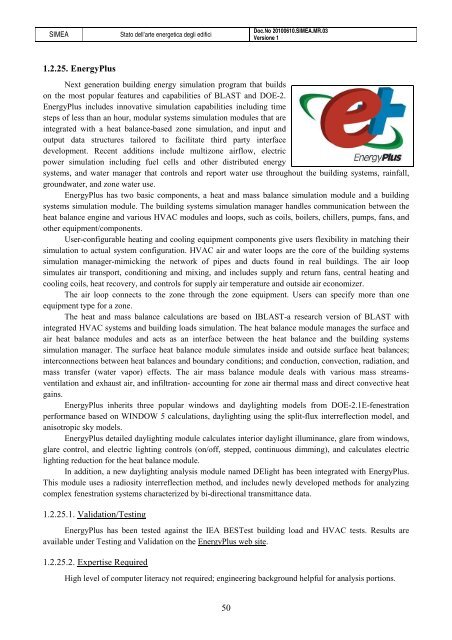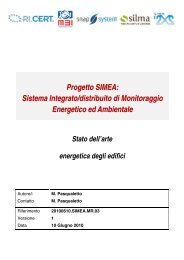Progetto SIMEA - Automatica - Università degli Studi di Padova
Progetto SIMEA - Automatica - Università degli Studi di Padova
Progetto SIMEA - Automatica - Università degli Studi di Padova
Create successful ePaper yourself
Turn your PDF publications into a flip-book with our unique Google optimized e-Paper software.
<strong>SIMEA</strong> Stato dell’arte energetica <strong>degli</strong> e<strong>di</strong>fici<br />
1.2.25. EnergyPlus<br />
50<br />
Doc.No 20100610.<strong>SIMEA</strong>.MR.03<br />
Versione 1<br />
Next generation buil<strong>di</strong>ng energy simulation program that builds<br />
on the most popular features and capabilities of BLAST and DOE-2.<br />
EnergyPlus includes innovative simulation capabilities inclu<strong>di</strong>ng time<br />
steps of less than an hour, modular systems simulation modules that are<br />
integrated with a heat balance-based zone simulation, and input and<br />
output data structures tailored to facilitate third party interface<br />
development. Recent ad<strong>di</strong>tions include multizone airflow, electric<br />
power simulation inclu<strong>di</strong>ng fuel cells and other <strong>di</strong>stributed energy<br />
systems, and water manager that controls and report water use throughout the buil<strong>di</strong>ng systems, rainfall,<br />
groundwater, and zone water use.<br />
EnergyPlus has two basic components, a heat and mass balance simulation module and a buil<strong>di</strong>ng<br />
systems simulation module. The buil<strong>di</strong>ng systems simulation manager handles communication between the<br />
heat balance engine and various HVAC modules and loops, such as coils, boilers, chillers, pumps, fans, and<br />
other equipment/components.<br />
User-configurable heating and cooling equipment components give users flexibility in matching their<br />
simulation to actual system configuration. HVAC air and water loops are the core of the buil<strong>di</strong>ng systems<br />
simulation manager-mimicking the network of pipes and ducts found in real buil<strong>di</strong>ngs. The air loop<br />
simulates air transport, con<strong>di</strong>tioning and mixing, and includes supply and return fans, central heating and<br />
cooling coils, heat recovery, and controls for supply air temperature and outside air economizer.<br />
The air loop connects to the zone through the zone equipment. Users can specify more than one<br />
equipment type for a zone.<br />
The heat and mass balance calculations are based on IBLAST-a research version of BLAST with<br />
integrated HVAC systems and buil<strong>di</strong>ng loads simulation. The heat balance module manages the surface and<br />
air heat balance modules and acts as an interface between the heat balance and the buil<strong>di</strong>ng systems<br />
simulation manager. The surface heat balance module simulates inside and outside surface heat balances;<br />
interconnections between heat balances and boundary con<strong>di</strong>tions; and conduction, convection, ra<strong>di</strong>ation, and<br />
mass transfer (water vapor) effects. The air mass balance module deals with various mass streams-<br />
ventilation and exhaust air, and infiltration- accounting for zone air thermal mass and <strong>di</strong>rect convective heat<br />
gains.<br />
EnergyPlus inherits three popular windows and daylighting models from DOE-2.1E-fenestration<br />
performance based on WINDOW 5 calculations, daylighting using the split-flux interreflection model, and<br />
anisotropic sky models.<br />
EnergyPlus detailed daylighting module calculates interior daylight illuminance, glare from windows,<br />
glare control, and electric lighting controls (on/off, stepped, continuous <strong>di</strong>mming), and calculates electric<br />
lighting reduction for the heat balance module.<br />
In ad<strong>di</strong>tion, a new daylighting analysis module named DElight has been integrated with EnergyPlus.<br />
This module uses a ra<strong>di</strong>osity interreflection method, and includes newly developed methods for analyzing<br />
complex fenestration systems characterized by bi-<strong>di</strong>rectional transmittance data.<br />
1.2.25.1. Validation/Testing<br />
EnergyPlus has been tested against the IEA BESTest buil<strong>di</strong>ng load and HVAC tests. Results are<br />
available under Testing and Validation on the EnergyPlus web site.<br />
1.2.25.2. Expertise Required<br />
High level of computer literacy not required; engineering background helpful for analysis portions.
















